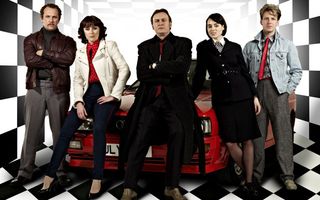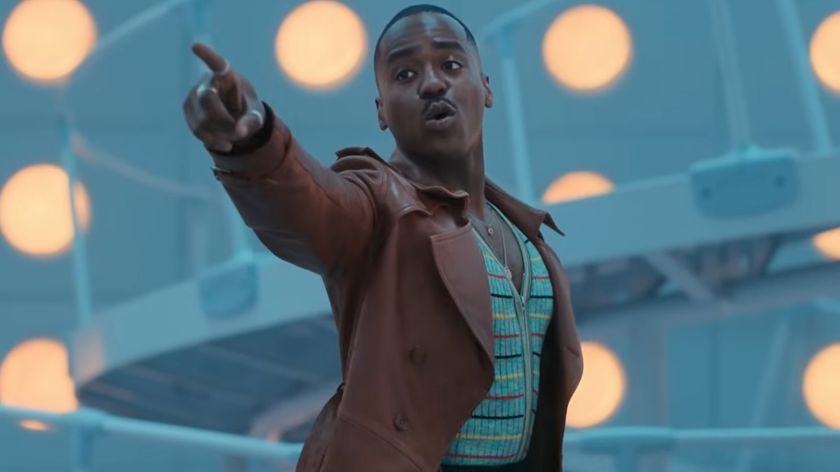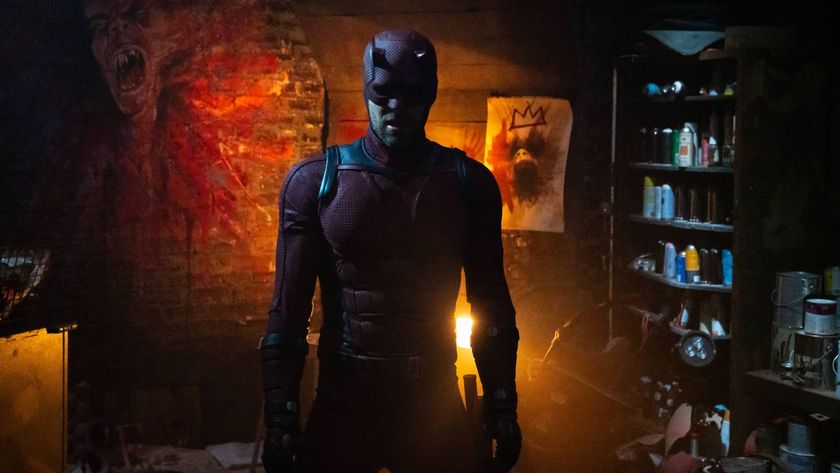Oi, slags! SFX is celebrating the return of Ashes To Ashes to BBC One with a week of thug-slapping, Quattro-spinning exclusives. Today we chat to Matthew Graham, the show’s co-creator and executive producer. Read on to learn how an Indiana Jones poster helped shape the show, why Alex doesn’t have all the answers any more and the potential 3D future for DCI Gene Hunt…

Life on Mars seemed to exist in a perpetual 1973 but with series two of Ashes you’re moving the action on from 1981 to ’82. Why the change?
It was a dramatic idea, really. Funnily enough, it had always been my intention with Mars to move it on each year. It seemed like the natural thing to do. And I’ll be completely honest with you, I can’t remember the reasoning behind keeping it in ’73, other than that the premise was very much about him waking up in 1973. We thought well, he’s not really in a place that’s ever going to age, even to the point where we talked about a Christmas special where he celebrated New Year and they all said “Happy 1973!”and you realised it was all cyclical. That would have been silly. But when we came to doing Ashes, right from the start we said we’d move it on a year if we had another series.
Do you think it was a hard fit getting Gene into the 1980s? Was it a transplant that took instantly?
I found it very easy to write the first episode [of Ashes series one]. I didn’t have a problem with reestablishing them in London. I felt we could get our heads round all of that. As the show went on it became slightly harder to keep that sense of mystery, of the magic of the unknown. So we fell back more and more on Alex saying “Well, you’re all constructs, and it doesn’t really matter” – and once we started to do that, once we started to not take the world as seriously, the audience inevitably didn’t either. Although I have to say, Ashes To Ashes was considered more accessible. We do a lot of audience research afterwards – some of it I think is a bit bullshitty, and some of it I find interesting. Usually the stuff I find interesting is stuff that proves me right! But one thing that was interesting was that Ashes To Ashes scored a higher audience appreciation than Life on Mars, by a significant amount. I think that’s because people like the 80s, but I also think it’s because there was just more of a sense of fun to it.
Do you think you picked up a more female audience?
Definitely. The Galex crowd as they’re called, who are obssessed with Gene and Alex. There was a strong female following that started to gather momentum, that wanted to see these two getting it on. There was actually a momentum in Life on Mars to see Sam and Gene getting it on, but that was a whole other fan fiction side of things that we don’t have to go into! That was probably called Gaylicks… In some ways what’s hard about starting Ashes was our self-consciousness. We did Life on Mars just doing what we wanted to do and not knowing whether anyone was even going to get it. With Ashes we knew everyone got what we’d done, and there was a sense of “Right, here we go…”
Sign up to the SFX Newsletter
Get sneak previews, exclusive competitions and details of special events each month!
I know Philip Glenister felt a little uncomfortable at the mythologising of Gene in series one. Is it tough to keep the reality of that character when he’s become such a TV icon?
Yeah, it’s an ongoing thing with Phil, and there’s no right or wrong. From my point of view, what I was trying to do was present him to Alex. So he was coming to Alex through her filter, as something that really embodied everything that she thought was naff and stupid about men – their desire to wear sunglasses and cowboy boots and to want to carry guns. I was actually trying to riff on that. And as I said to Phil, and all the cast at various points, we are making something with a movie sensibility, that’s what we do. That’s my raison d’etre for television, to try and bring movies into television. When it works it works, and when it doesn’t it seems very at odds with TV. It’s a bit of a dangerous game to play. Do you remember the Temple of Doom teaser poster? It was basically Harrison Ford in a ripped shirt, and it said something like ‘In Raiders of the Lost Ark he was a hero, now they make him a legend!’ And that was really what was knocking around in my head when we did Ashes. Now we make him a legend… So we were playing up on that, yeah.
How did Phil take that?
Phil’s got a good radar for that stuff. Even down to the day before the last day of filming this time around, he said “Can I have a word with you?” And I thought “Oh God, what’s he going to moan about…” [laughs] and he came in and he had a really good point about his big end speech, which was a really important speech at the end of the series, that reveals a little more about the bigger world. And he said “With respect, I just think it’s overwritten. I know what you’re going for and I think you’ve pushed it too far.” And I thought he had a point – I looked at it again and I toned it down and then I added in a couple of gags, a few Geneisms to rough it up a bit. He was saying it was all a bit mannered, a bit aware of itself and the importance of what it was saying, whereas if I’d just messed it up a little bit and threw in a few off the cuff remarks it would just carry more believability. And I think he was absolutely right.
Are you writing Alex differently? She seemed to take a critical battering in series one – did that impact on the way you wrote her in series two?
Well, because the storyline is evolving and she’s learning more about the world that’s undermining what she thought, yes, I am. What she’s not doing so much of now is walking around calling them constructs. I have to be honest with you, I wasn’t entirely aware of the criticism to begin with. I wasn’t too worried about the critical response to the show – I wasn’t looking out for it and analysing it. I think it was partly because I felt fairly bullish after Mars, so I just kinda thought people who get it will get it. So I wasn’t as conscious of it as Keeley was, or some other people were. I think it’s a really interesting performance this time around. As I say we’ve evolved the storyline, so Keeley inevitably has to play it darker now – she’s not going around calling people constructs and saying none of this matters. She actually starts thinking that a lot of this matters a great deal.
What was the biggest creative challenge of series two?
The biggest creative challenge was to develop the mystery in a way that really surprised people and took it to the next level. And just keeping that balance between Gene and Alex so that the sexual tension is there without it ever becoming too soppy – you don’t want it to become a show about “Will they, won’t they?” That would be tedious. And at the same time you do want that sexual frisson in there all the time. It’s about getting the balance really.
Do you use music to inspire you when you’re writing the scripts? I can imagine you cracking open Now That’s What I Call 1982…
Yeah, I do. I don’t play music while I’m writing – Ash [Pharoah, co-creator] does, I think. What I tend to do is put music on for half an hour, first thing in the office, 8.30 in the morning, have a coffee. If I was doing Ashes I’d get my iTunes collection together and make my own album of ‘82 stuff, play that for half an hour, get into the zone and then start writing.
Any guilty pleasures in there?
Oh yeah…
Charlene’s I’ve Never Been To Me?
No! Probably the guiltiest pleasures are things like Avalon by Roxy Music…
What’s wrong with that?!
Nothing, it’s a wonderful track!
You get to cherrypick the charts, then…
We do. All the writers are encouraged to cherrypick their ideal soundtrack. Sometimes you can’t get it, obviously, for rights issues, or other times the director or the editor puts in something else that works better. In the Tower Bridge sequence in episode one of Ashes I wanted Flash by Queen… I had it in my head and I knew it was going to work, just hearing that dum-dum-dum-dum-dum-dum while the baddie says to Alex “No one’s going to help you know…” And then we see Gene. Flash! Ah-aaaah! And I was convinced that was going to work brilliantly. And Johnny Campbell the director very dutifully put it on to the scene… and it didn’t work, because there was too much talking, too many bloody quotes from the film going on, and it started to muddy. So it was the editor and John who came up with No More Heroes by the Stranglers, which was also a very good choice. I definitely tell all the writers to put music in the script, because it’s part of the character of the show. You’ve got to get your music right.
Do you think it was easier for Life on Mars to target the TV of the 70s? 80s TV doesn’t seem to lend itself as well to that kind of satire…
It doesn’t, no, you’re right. It’s a little bit more contrived, a little bit more of an awkward fit, but it’s an aspect of the show that people really like. I’ve done something in episode 8 where I’ve embroiled Gene in a beloved children’s television show, and that’s worked surprisingly well. We haven’t done that before.
What do you think will surprise people about series two of Ashes?
I hope episode one will surprise them, because episode one is, for much of its part, a really top drawer episode of Ashes to Ashes, but in the last 15 minutes it goes kinda nasty and dark and adds another level to the whole thing. When we’ve shown it to people they’re like “Whoa, we’re getting the shivers…”
You’re storylining series three now. There’s obviously pressure on you to deliver a Big Ending. Are you tempted to end it like McGoohan ended The Prisoner, with Gene ripping off someone’s face to reveal a cackling ape?
No, not quite! I have been heard wandering around the corridors of Ashes To Ashes mumbling about a 3D episode… I’m being ignored, quite frankly! Politely and graciously ignored while I mutter about 3D, and about how this time next year James Cameron will have conquered the world through 3D. And 1983 was the year of a 3D revival, of course… We’ll wait and see. That battle is still being fought!
Nick Setchfield
Ashes To Ashes series two begins tonight on BBC One at 9pm
Keep ‘em peeled: later this week we’re bringing you interviews with stars Keeley Hawes and Philip Glenister! Why, it’s so exciting you could ram a Rubik’s Cube up a lawbreaker’s fundament.
SFX Magazine is the world's number one sci-fi, fantasy, and horror magazine published by Future PLC. Established in 1995, SFX Magazine prides itself on writing for its fans, welcoming geeks, collectors, and aficionados into its readership for over 25 years. Covering films, TV shows, books, comics, games, merch, and more, SFX Magazine is published every month. If you love it, chances are we do too and you'll find it in SFX.
Most Popular







